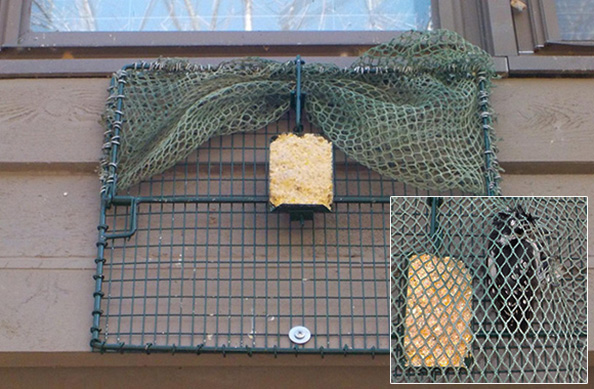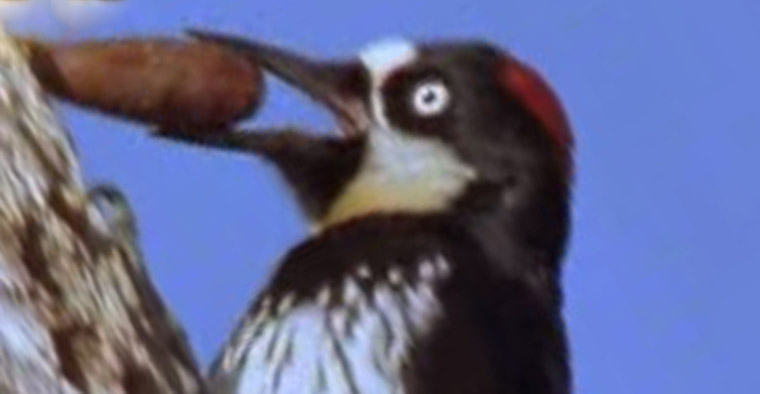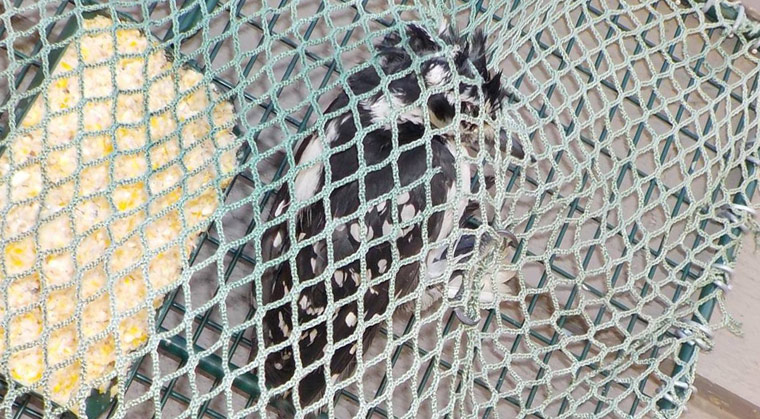-
info@aaanimalcontrol.com
Call us for help in your town
Humane Wildlife Education
Woodpecker Trapping on House
Need woodpecker removal in your hometown? We service over 500 USA locations! Click here to hire us in your town and check prices - updated for year 2020.
How to stop woodpeckers from pecking on your house:
If a woodpecker is destroying your wooden siding, there are several steps you can take to stop the pecking and to prevent the problem from reoccurring. Hanging aluminum windmills, foil strips, or similar shiny, reflective materials may scare the woodpecker away. Woodpeckers are also easily frightened by noises, so a motion sensor that emits a sound, or some hanging wind chimes, might prevent the woodpecker from returning. Some use fake, plastic predators. The woodpecker may become accustomed to seeing the noise or motion devices or fake predators after a few days and return. Woodpecker trapping: Woodpeckers are considered birds that are extremely interesting as well as exciting. They are beautiful creations of nature, but can cause serious kinds of damages with pecking. Pecking is fine when it is in forests, but it can create serious problems if woodpeckers will select your house for pecking as it can only inflict serious kinds of damages. Every year property worth millions of dollars gets damaged because of woodpeckers so it is a serious problem, which should be given proper care and treatment. Homeowners are always in search of methods that can be used for making their property safe. Some of the common complaints which are put forward in this regard are being mentioned below
-They make holes in the exterior surface of house
-A lot of noise is created with their presence which is sometimes difficult to bear
-They also damage trees because more than enough holes bring extensive harm and even death of the tree which is severely affected.

How to trap a woodpecker: with this special trap here!
It is therefore extremely important that proper measures should be taken for controlling woodpecker activity in your house otherwise it will get out of control. In case you are noticing the activity of woodpeckers more than often then it’s high time to realize that something is present, which is attracting these birds. For repelling them the best thing you can do here is to eliminate the source of attraction which is present. There can be different cases like they might have found something to feed or the case can be that a proper nesting spot has been identified by the woodpecker. Regardless of the fact that what type of problem it is its best to take proper steps and solve before it gets out of hand or too difficult to manage or handle.
Getting rid of woodpeckers with traps
There are various strategies which can be applied here, but trapping is considered as the safest and most effective method, which delivers timely results. Let’s discuss two common types of traps that can be used in this regard.
Net Trap
Generally rat trap is fixed with trees using screws that are placed above entrance cavity so that the net or board falls over hole when it’s sprung. The trap is normally fixed by means of guiding nylon cords via staple placed off to and above trap’s side. Cord is allowed to reach ground and it is tied to the tree for the purpose of keeping the trap set. Whenever, an adult bird enters inside cavity observer who will be waiting will cut cord and it will release the trap. If attempts are made by the woodpeckers for pushing trap so that it can open, then its efficiency can be improved by means of attaching weight as well as line of nylon to board. Net trap is generally considered as ideal for capturing woodpeckers that have small nest openings so it really gets impossible to extend reach towards woodpeckers that feed nestlings without getting entrance into cavity. This is a trap that is normally considered as ideal where birds will not require cavity for being trapped. Normally when bird is present in cavity it will fly into the net this is an approach which will eliminate problems related with bird removal from cavities.
Board trap
Board trap is normally used for the pileated woodpecker who still feed nestlings from cavities that are present inside cavity as it exposes them to lesser stress. The bird is trapped in such a ways that you can easily remove it using hands, but it’s important to be careful all the time.
Experts normally suggest that one should only start trapping when nestlings get 8 -12 days old. This is the age at which nestlings get mature enough for skipping feeding. It is better that time should be given to the mother bird so that it can properly feed the babies. Leaving the baby birds on their own to die is not the right thing to do in all cases. You have to adopt a humane approach in fact there are also laws which forbid such practices.
Diet of woodpeckers normally consists of grubs or insects, which are commonly available in trees. So you can also use insects or grubs for setting bait. Other different kinds of traps are also very much common like there is a specialized trap that’s birdhouse which includes mouse snap trap present inside and it is good enough for killing the bird. However, this is not a legal approach also killing the birds is not the best thing to do. Live traps are best where you can capture the bird without inflicting any kind of serious harm to it. Specialized funnel traps are also present which permit woodpeckers to gain entry, but they are unable to get out. It also brings minimal harm. There is also a practice of using sticky substance on the surface of pecking, but it’s not a good choice because the bird will eventually get stuck permanently and you will be left with no option other than killing because the bird will be in great pain. It’s best to go with live trapping techniques.
Woodpecker Trapping
Need bird removal in your hometown? We service over 500 USA locations! Click here to hire us in your town and check prices- updated for year 2020.
There are a number of reasons why we do not advise trying to trap woodpeckers as a way to remove a pecking problem from your home or property. It is a very common misconception that using a form of trapping and release is the best method of dealing with wild animal invasions, but for many species, the trapping alone can be too stressful for the animal to survive through.

Wild animals don't know that humans aren't predators, as so many of them actually are. They don't know that you are trying to help them, or that you have intentions of releasing them back into the wild. When cornered or threatened, many wild animals will attack, and this means that you will be put in direct danger if you try to trap any wild animal, woodpeckers included.
Then, of course, there is the threat of disease to worry about. Bird droppings, just like the droppings of other wild animals, is rife with disease-bearing pathogens, and clearing up up dry debris can be just as dangerous as fresh feces, not just to humans, but other animals also.
When an animal is stressed, a number of things happen to the body, and the average woodpecker is going to be beyond a “little stressed” when you have it caught up in a tiny trap. Increased breathing rate combined with elevated heart rate can make it difficult for the animal to react to a situation in a sensible and thought-out way, and also makes it very difficult for the animal once it has been released again. Not only does the creature need to find food, water and shelter, but it needs to do those things with an elevated heart and breathing rate. They'll get exhausted quickly, and this means they are likely to come under attack from predators and come off worse. The change in hormone levels in the body could also make the animal more susceptible to other medical problems, including deadly diseases.
Trapping and releasing doesn't seem quite so humane now, huh?
It gets worse.
When you release an animal into a brand new environment, such as a woodpecker, you are releasing it somewhere where it has likely never been before. It won't know where to find food, water or shelter, and it won't know where any of it's family or friends are. If you have taken a mother from her nest, she will panic, desperately trying to find a way home to her babies. The woodpecker is immediately at a disadvantage when you release it, not only because it is still going to be stressed, and suffering with the physical symptoms of that, but also because it won't know where it is. It won't have time to sniff out the area.
If there are already woodpeckers in the particularly territory you have released the bird into, the newly released bird will need to come into contact with a hierarchy of animals that is already in existence. Native male woodpeckers to the territory will battle new males for mating rights, as well as territorial ones, and there will be the new battle over food too. You have introduced an animal that will compete with existing animals for food. If there's only just enough to go around now, there won't be enough to feed everyone. It probably won't make too much of a difference when you release one woodpecker back out into the wild, but if all homeowners did that to every woodpecker that invaded homes and commercial properties, the ecosystem would be all out of whack. That's why no one should do it.
What happens if you introduce a woodpecker into an area it doesn't already have a population in? Admittedly, the chances of finding a woodpecker-free zone across North America is slim, but you will be introducing something brand new to an environment it wasn't present in before. If the bird is carrying any diseases, those diseases will be spread. New diseases will evolve, new creatures will breed with existing creatures, and things go a little crazy. That's how we [humans] end up with antibiotic resistant bugs that we struggle to treat.
Finally, we want to go back to the legalities of moving wild animals, particularly from urban areas. With some creatures, it is illegal to trap them, harm them, or move them, and this is definitely the case with bats. There are certain species of woodpecker that are known to be a fast downward decline, and you would get into a lot of trouble if you were to harm any of those populations.
Woodpecker trapping is a very bad idea, for all the reasons we have already listed and a whole host more. The humble woodpecker offers much more to humans in terms of benefits than they do disadvantages, and all care should be taken to ensure these creatures are treated with respect. This is even more so the case when you bear in mind that many of the numbers are already declining … fast.
Learn more about the damage woodpeckers can do: What kind of damage can woodpeckers cause
Woodpecker trapping
Need bird removal in your hometown? We service over 500 USA locations! Click here to hire us in your town and check prices- updated for year 2020.
A woodpecker is an animal that can do a great deal of damage to your home. Because of their sharp beaks and their propensity to keep pecking away at the side of your home to either take out bugs or other organisms, or to create a place to find shelter, they can be incredibly destructive to your home.
Because of this, you may find that it is necessary to trap this woodpecker and either turn it over to some kind of animal control agency or move it to a new location. The fact remains that you simply can't have a bird like this around your home when the damage that it can cause can be quite extensive. This is a serious risk, and is why a bird trap would be a sensible product get to assist you and removing this animal.
However, standardized traps that you would get for most birds are not going to do the trick for you. You need a special kind of trap that are specifically designed for woodpeckers to be able to capture them.
The problem with the majority of these traps that you will find is that they are not geared to simply trap the animal. They are built very much like a standard mousetrap, yet inside a birdhouse. In other words, there is a mouse snap like accessory to the trap that will kill woodpeckers once they go inside of it. In fact, any bird that goes inside of it is doomed for death.
This creates a dilemma for some. In many areas of the country you may find that the killing of a woodpecker is actually illegal. Even if killing woodpeckers are acceptable, as mentioned, other animals can get inside this trap and be killed. This can mean that a different kind of bird, one that is protected, can get into your trap and be crushed by the mechanism inside. This can lead to serious legal problems for you.
There are other kinds of traps that you can get, with one of the most common being a sticky kind of trap. You staple a piece of glued material to a board, and when the woodpecker lands on it it gets trapped against the sticky material and cannot get away. Eventually, the bird will either die or you can remove it and take it to another location.
The problem with this kind of trap is the same kind that you would face with the previous one that was mentioned. This can still be illegal for you to use because of the damage that it can cause to the bird.
What you may find as the only option available to you is for you to hire an agency that would be willing to come out and capture the woodpecker for you, thus removing it and taking it to a safe location. This can be costly, but at least it ensures that you aren't going to be in violation of any laws that could land you in hot water.
Woodpecker trapping
Need bird removal in your hometown? We service over 500 USA locations! Click here to hire us in your town and check prices- updated for year 2020.
A woodpecker is an animal that can do a great deal of damage to your home. Because of their sharp beaks and their propensity to keep pecking away at the side of your home to either take out bugs or other organisms, or to create a place to find shelter, they can be incredibly destructive to your home.

Because of this, you may find that it is necessary to trap this woodpecker and either turn it over to some kind of animal control agency or move it to a new location. The fact remains that you simply can't have a bird like this around your home when the damage that it can cause can be quite extensive. This is a serious risk, and is why a bird trap would be a sensible product get to assist you and removing this animal.
However, standardized traps that you would get for most birds are not going to do the trick for you. You need a special kind of trap that are specifically designed for woodpeckers to be able to capture them.
The problem with the majority of these traps that you will find is that they are not geared to simply trap the animal. They are built very much like a standard mousetrap, yet inside a birdhouse. In other words, there is a mouse snap like accessory to the trap that will kill woodpeckers once they go inside of it. In fact, any bird that goes inside of it is doomed for death.
This creates a dilemma for some. In many areas of the country you may find that the killing of a woodpecker is actually illegal. Even if killing woodpeckers are acceptable, as mentioned, other animals can get inside this trap and be killed. This can mean that a different kind of bird, one that is protected, can get into your trap and be crushed by the mechanism inside. This can lead to serious legal problems for you.
There are other kinds of traps that you can get, with one of the most common being a sticky kind of trap. You staple a piece of glued material to a board, and when the woodpecker lands on it it gets trapped against the sticky material and cannot get away. Eventually, the bird will either die or you can remove it and take it to another location.
The problem with this kind of trap is the same kind that you would face with the previous one that was mentioned. This can still be illegal for you to use because of the damage that it can cause to the bird.
What you may find as the only option available to you is for you to hire an agency that would be willing to come out and capture the woodpecker for you, thus removing it and taking it to a safe location. This can be costly, but at least it ensures that you aren't going to be in violation of any laws that could land you in hot water.


















